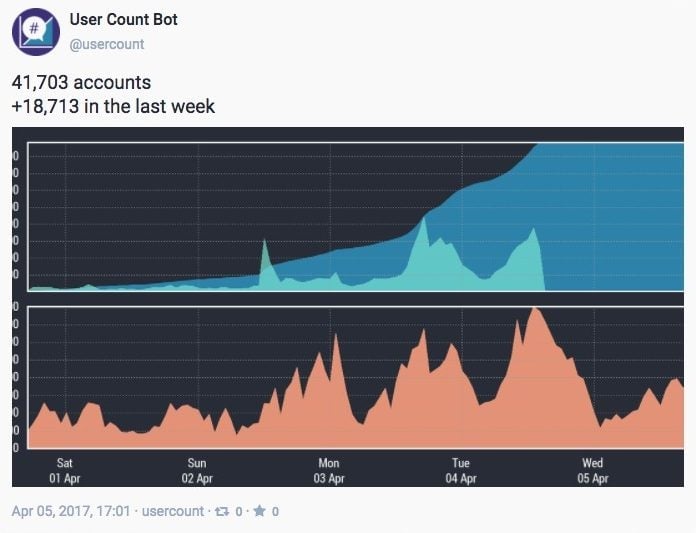How to use Mastodon, the Twitter alternative that’s becoming super popular
There’s a new social network in town. It’s Mastodon, a six-month-old microblogging service that’s more than a little like Twitter—although it promises not to serve you ads, and is open-source instead of being owned by a corporation. If you’re fed up with trolling, fake-news saturated feeds, and algorithms you can’t fathom, take a look at Mastodon.


There’s a new social network in town. It’s Mastodon, a six-month-old microblogging service that’s more than a little like Twitter—although it promises not to serve you ads, and is open-source instead of being owned by a corporation. If you’re fed up with trolling, fake-news saturated feeds, and algorithms you can’t fathom, take a look at Mastodon.
The new network’s userbase has been exploding, overwhelming its servers. It has added at least 18,700 new users in the past week alone, according to one bot that tracks user numbers on one part of the network.
Its newfound popularity can be traced to the fallout from the new way that Twitter handles its mentions, which users have complained is deeply confusing, and the general abuse that proliferates on the platform. It bears noting that Mastodon’s userbase is still tiny, at about 120,000 users compared to Twitter’s 313 million monthly active users.

Mastodon is like a utopian version of Twitter. It’s focused on limiting abusive speech and promoting privacy, it doesn’t have to chase growth mandated by venture capital, and it’s decentralized. But we’ve heard this story before with wannabe Facebook killers like Ello.
What might give the new network a shot at surviving—and maybe even thriving—against existing services like Twitter is a perfect storm of social and political factors. People are sick of Twitter eggs trolling them, fake news, YouTube ads funding hate-speech, and opaque algorithms dictating their feeds. Mastodon offers privacy, a simple chronological timeline, and no advertising. ”I am not interested in VC funding, monetizing, advertising, or anything of that sort,” Mastodon founder Eugen Rochko has written.
Rochko is motivated by the philosophy behind open-source software and ethical design. “It’s built for people, by people, under the scrutiny of people,” he’s written. Mastodon feels like a throwback to early internet services, which were motivated by a similar ideology. It’s populated by mavens like anime obsessives, Minecraft fans, and cyber security enthusiasts. The experience is a cross between Twitter and IRC, a popular early form of decentralized internet chat.
Mastodon was kickstarted with $800 in crowdsourced funding to pay for server bills and Rochko’s living costs. But using Mastodon can be tricky, at least for now. Some of its features look familiar enough, but can still take getting used to.
For starters, a post isn’t called a tweet on Mastodon—it’s known as a toot. There’s more. Here’s a guide to how to use Mastodon:
Signing up
Generally, you can create a Mastodon account at Mastodon.social. But the service has been overwhelmed by new users, so it’s stopped accepting registrations temporarily. This forces new users to understand how Mastodon’s decentralized system works. Mastodon.social is the most popular “instance” on the Mastodon network. Each instance is basically a server, and anyone can run an instance. Generally, users on one instance can see posts by users on all the other instances.
When you pick an instance, keep this in mind: It will form part of your username. For example, I made an account on social.tchncs.de, which makes my Mastodon handle for that account: @[email protected]. This is important because it’s what you share with others when they want to search for you or follow you.
Many instances are pausing registrations because they’re full of new users. Check out instances.mastodon.xyz to find an instance that’s taking new users.
Picking the right instance
Most instances are pretty vanilla. You make an account and you sign on. But some instances have special rules and features. For example, awoo.space is moderated by a volunteer team, selected by that instance’s admin, to “resolve conflict and minimize abuse.” The cybre.space instance calls each post a “florp” instead of a “toot.” The memetastic.space instance lets users “give some street-cred” instead of simply “favoriting” a post.
You can use the same username on different instances. I use @joonian on both social.tchncs.de and the Minecraft-themed fern.surgeplay.com. But each account has its own set of followers and posts. They are separate entities.
Also, the current fad is to add a checkmark alongside your username, to gently mock Twitter’s Verified accounts, which have blue check marks. There’s no verification on Mastodon: You can add a checkmark by simply pasting this emoji ✅ in your bio.
Using timelines
Unlike Twitter, you can see public timelines on Mastodon without having to follow anyone. These timelines are also strictly reverse chronological, with no algorithm to decide that some posts are more important than others.
Once you’re in, you’ll be presented with two timelines: local and federated. A local timeline shows all public toots from users on your instance. You can think of it as a mailing list for everyone in your town. The federated timeline extends the local timeline by one degree of separation. It shows all the public toots from people who are followed by the users of that instance. So the more people on an instance who follow others, the bigger the federated timeline. This is a bit like when someone at a big company copies the entire staff in an email. It’s a lot of people’s toots, constantly. Correction: An earlier version of this article said federated timelines show all public toots on all instances.
You can follow users from any instance. This bit is like Twitter. You’ll see their toots in the “Home” tab. If anyone mentions your username, you’ll see it in the “Notifications” tab.
Instances are like email services
The sum of all Mastodon instances forms part of the “fediverse.” One analogy is to think of Mastodon instances as email services. Gmail and Yahoo Mail have slightly different interfaces and features, and they’re operated by different companies. But users of one service can still communicate with users of another service.
Toots have a 500 character limit
Each toot is limited to 500 characters, unlike Twitter’s 140 character limit. Mastodon’s creator, Rochko, says this is to allow for “more nuanced conversations” and less “tweetstorming.”
Instead of retweeting, you “boost” a toot. Instead of “likes” for tweets, you favorite a toot. Also, there’s no counter for boosts and favorites in the main timeline view, unlike Twitter, so you won’t know how many times something’s been boosted unless you click on it to see the detailed view. It’s less of a popularity contest, as this user pointed out, and more about the quality of the conversation.
Sending a direct message
Although privacy is Mastodon’s big sell, it’s not immediately obvious how to send a direct message on the service. You do so by clicking the globe icon 🌎 just below the toot text box. Select “Direct” and your message will only be seen by users who you mention. The globe icon should also have changed to an ✉️ envelope icon.
Each toot has its own privacy settings
Here’s the other thing that’s not like Twitter. Weirdly, it’s more like Facebook. On Twitter, you can either make a tweet public or make all of them private by making your account private. Mastodon’s toots offer finer control; they are more like Facebook status updates. You can set who sees each toot.
You do so by clicking the globe icon 🌎. You can make a toot unlisted 🔓, meaning it can be seen by anyone, but it won’t be added to the local or federated timelines. You can make a toot private🔒, meaning only your followers see it. Or you can make it public, which will add toots to local and federated timelines. You can set a toot’s default privacy level as well.
Adding warning labels to toots
You can add a content warning to toots. Click the “CW” button below the toot text box. This will create a new text box with the label “content warning” on it. Write your warning there, then put the rest of the content in the usual toot text box. This hides part of the content behind a “show more” button. This is useful for NSFW content, or anything else a user might deem sensitive to her followers.

Mastodon has its own Twitter egg…
Mastodon’s default avatar is a “smiley face” that looks a little like a chick hatching from an egg.
…and its own Fail Whale

There are a bunch of Mastodon mobile apps
You can access Mastodon through a web browser on a desktop or phone, but you can also use third-party apps for Android or iOS. Here’s a list. Some apps have fun features, like Amaroq’s “awoo mode“, which transforms all toots into awoos.
Twitter actually has better data export options
Mastodon’s supposed to be user-centric, but it has fewer data export options than Twitter. Mastodon lets you export lists of users you follow or block, while Twitter lets you download all your old tweets, a log of devices used to access Twitter, and much more. Mastodon’s export options could improve, of course, as more developers contribute to its code.
What’s more, Twitter has more uniform privacy protections. On Mastodon, users have to trust the admins who run each instance with their data. That means users have a choice, but it could also be open to abuse. It’s not clear what user data an admin could access—I’ve asked two admins, and haven’t heard back from Rochko—but it’s a disconcerting possibility. Twitter has a blanket privacy policy. Yes, that means you have to let it track you and serve you ads, but it’s rated highly for privacy measures by the Electronic Frontier Foundation.
Whatever you do, don’t tweet about Mastodon on Twitter
It might earn you a sarcastic reply from the heavy metal band Mastodon, who is currently promoting its album “Emperors of Sand.”
Instead, you might satisfy your Mastodon cravings (Rochko is a fan, too) by following this account, from an unnamed Quartz journalist, that exclusively toots Mastodon gifs. Happy tooting.